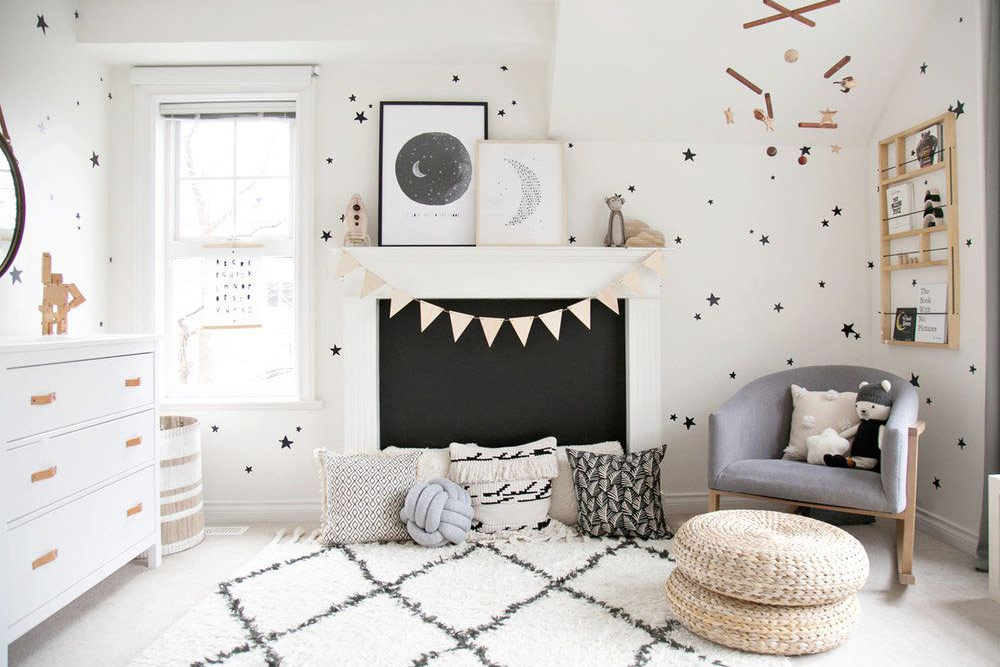A child’s bedroom should be a haven, a space they love spending time in, where they feel safe as they drift off to sleep and comforted by what they see when they wake up in the morning.
It’s their personal space and the elements are crucial for their mental and physical health, especially nowadays when we live in a crazy, fast-paced world filled with an unprecedented level of stimulation. A healthy bedroom is where the mind, body, and soul re-calibrate, whether your child is a toddler or a teenager.
Designing and decorating your child’s bedroom to reflect who they are is important for creating a place they can relax in, learn in and take inspiration from. I’m a huge believer in getting kids involved in the design of their own room; allowing even the youngest of children to tap into their creativity can be hugely beneficial for them. Aside from encouraging them to think outside the box, creativity helps them:
- Deal with change
- Problem solving
- Affects social and emotional intelligence
- Enhances understanding of maths and science
- Is a key component to health and happiness.
One of the best parts about designing a child’s bedroom, whether it’s a baby’s nursery or a teenager’s hideaway, is that the choice of style, colour, and design is all but endless. The downside is that a child let loose has a lot of choice!
Luckily, limits don’t hinder creativity, they can actually help, so set some boundaries and follow these golden rules:
- Lighting. Just as for other rooms, children’s bedrooms should have a range of light sources for flexibility. Some of these options need thinking about during the early stages of designing the room while others can be later additions.Ambient light for the room is sometimes provided by a ceiling pendant, down lights or track lighting. You might want to hang a pendant with an attractive shape (to throw interesting patterned shadows), or in a beautiful colour. If the design leaves the room without adequate all-over light, supplement with down lights but whatever you choose, always install a dimmer.
Bedside lights may need to offer different functions at different stages. For younger children, a nightlight can provide a comforting glow but for reading a bedside lamp should be bright enough to avoid eyestrain.
Desk lights need to illuminate the whole desk area, including computer screens, and the bigger the expanse of desktop, the taller the lamp needs to be. A design that can be angled is useful to direct light to the current working area whether screen or paper. Kids need less light than adults, but look for a lamp with around 450 to 900 lumens.
Decorative lighting can be a great way to personalise a scheme. Fairy lights around a bed frame or plug-in LED strips are low-cost ways to keep up with changing tastes.
- Acoustics. While good insulation inside the bedroom walls is necessary to muffle sounds from outside the room, the materials you use within your child’s bedroom are also a factor. If you have a hard floor, definitely invest in a good rug and soft drapes or blinds rather than shutters or wood blinds.
- Clever Storage. From receiving sacks of toys for Christmas and birthdays to the hordes of clothes girls, and indeed some boys, seem to collect through their teenage years, storage needs lots of forethought and should be considered early on in the design process.
Adjustable shelving is a good idea for a successful kid’s room design. That way it can be adapted to books, photos, mementoes and more. It needs to be safely fixed to the wall and accessible, of course – remember anything unreachable won’t be used.
A mixture of open and closed storage is best. It’s important they can have favourites on show at every age, but being able to shut the door on stuff that’s used less frequently will help keep the room tidier.
Modular furniture is a good idea as new units can be added as collections grow. Chests are useful for medium to larger toys when they’re little, and for anything from old schoolwork to out-of-season clothes in later years. Alternatively try a specifically designed window seat with a lift-up lid, or an upholstered storage ottoman.
For younger children’s rooms, easily movable bins and baskets will help you sweep the clutter off the floor and out of the way swiftly. Transparent drawers will help kids find the toys they’re looking for more easily.
- Limit stimulation. A messy and crowded child’s bedroom is highly disruptive to sleep patterns (even with the lights off!) so tone down bright primary colours and character patterned bedding if you want the space to prime your child for a good night’s sleep.
There’s a reason that nurseries have long been designed in pale pink, baby blue, or soft yellow, they’re soothing hues. So, while you might want to be more adventurous, bright bold colours are too stimulating to be good choices for a calming kid’s room. Also avoid high-contrast palettes and busy patterns on walls, bedding or rugs.
A better option is to create a base of soft neutrals like grays and taupes or pastel colours – experiment with lavender or pale green if you want to avoid the standard pink and blue. Neutral paints also have the advantage of longevity; as the child grows, the backdrop can stay the same while the accessories are changed.
Subtle wall stickers, can add interest to children’s rooms, and are easy to remove when they tire of the design. Not just for little ones, there are options available to please kids from nursery age to sophisticated teens. Simple gold stars on a painted wall can make a room come alive.
- Avoid themes. Your child may be fixated on Spider-Man at the moment or can’t get enough of dinosaurs but in a year from now they might cringe with embarrassment at their former fixations. With this is mind, it can be a good idea to avoid decorating a room in a certain theme, or you may find yourself redecorating it every 12 months!
Using and designing around natural elements sends a subliminal message to the brain to feel calm. The colours, sights, sounds, scents, and textures found in nature present the most perfect balance and are the greatest source of inspiration for all my schemes. One way to bring nature inside is to incorporate images of the outdoors into your child’s bedroom. Photos help children learn how to observe details around them and they learn how to appreciate everything nature does for us as a whole.
- Make it cosy. Kids need to feel safe and secure, so fill your child’s room with items they can use to self-soothe, like a large soft blanket with enough weight to feel like a hug. Bedding, pillows, and rugs should be soft to the touch, so feel all materials before bringing them into the room.
Wallpaper is another route worth considering if you’re looking to design a cosy room with plenty of personality. Many children’s wallpapers are bold and busy, so avoid these. Instead, go for something neutral with texture or one of the beautifully stylish ethereal designs.
- Plan ahead. It may be difficult to imagine your lovely little boy having long dangly basketball player’s legs in the future, but the time will come when your baby grows out of his gorgeous little toddler-sized bed. It’s wise to plan your child’s bedroom design around the fact that this is still likely to be their room when they are eight, 15 and possibly 21 years old. Ask yourself: Will a full-size bed fit in? Where will friends sleep? Are their enough electric sockets?
Once your child is old enough to have regular homework and study time, he or she needs an area designed for focused schoolwork and another area to relax and daydream in. You don’t need anything elaborate – a simple desk and adjustable chair is enough for homework time, and a comfortable chair, beanbag or floor cushion are perfect for much-needed downtime after a hard day at school.
Uber Haus
We are a leading design studio based in Farnham, Surrey, specialising in luxurious, liveable and individual interiors for private residential clients.
Our approach is refreshingly simple. We listen to our clients, get to know them, and give them a liveable space to suit their lifestyle and their tastes.
If you’d like to talk about decorating a child’s bedroom or you want to add a touch of luxury elsewhere in your home then contact Uber Haus now for a free consultation.

